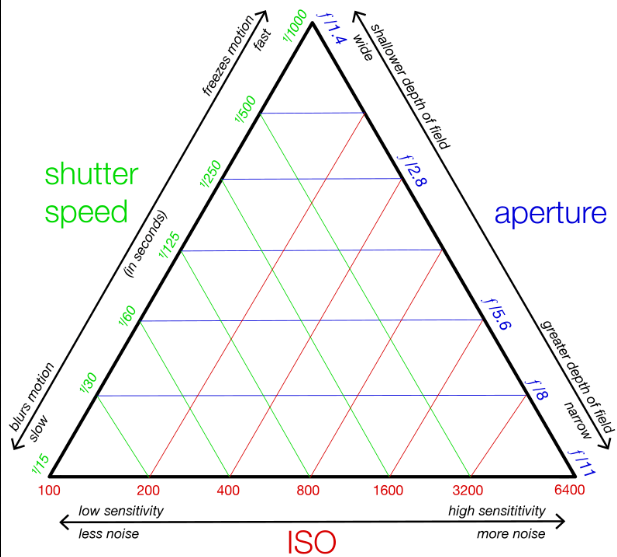
WooHoo, You Got Your First “Real” Camera
You bought your first “real” camera and now you’re ready to go out and grab some awesome pictures. The only problem is when you look at your camera there are a bunch of buttons/dials and you have no idea what they do or mean. To make matters worse when you “Google” it, the language they use makes absolutely no sense to you. For now, don’t worry too much about the terminology. Everything on this website will help you learn about the world of photography. In this post, I am going to help you in understanding your camera settings.
Understanding your camera’s settings is not just about taking good photos; it’s about capturing moments exactly the way you envision them. Whether you’re a hobbyist or a professional, getting a firm grip on these elements will elevate the quality of your work significantly.
Exposure Triangle
Lets take a look at the ‘Exposure Triangle’, which is the foundation of all things photography. This trio, made up of Aperture, Shutter Speed, and ISO, is critical because it balances the light that enters your camera to create an image. Just don’t focus too much on perfection right out of the gates – mastering these settings is a journey.

Exposure Triangle Photo Courtesy of Wikimedia Commons
Aperture
Choose something that resonates with you, perhaps starting with what affects the mood and feel of your photos the most. In my opinion, the aperture is a great place to begin since it’s so influential in both the technical and artistic aspects of your images. You can manipulate it and control light and achieve the desired depth of field in your photographs.
Controlling the Light
Aperture is the eye of your camera, and how wide or narrow that eye opens can greatly impact your photos. Think of aperture as a window; larger windows let in more light, and smaller windows allow in less. In the world of cameras, we measure this ‘window size’ using f-stops.
F-Stops
So, how do you decide which aperture to use? Aperture openings are measured in “f-stops”. An f-stop is a fraction of the focal length of your lens. It’s not just about the amount of light; it’s also about controlling the depth of field. Want everything sharp from foreground to background? You’ll be bumping up to higher f-stops. Do you want a blurry background with your subject in sharp focus? Lower f-stops are your friend.
Tell Your Story
This isn’t just a technical setting, it’s about artistic expression too. Aperture shapes the story you’re telling with your photographs. A narrow aperture can give equal importance to all elements in the frame, while a wider aperture can pinpoint your subject and make it stand out.
Priority Mode
But don’t worry too much about mastering every detail right away. You will need to go out and practice taking shots with different settings to help you get started. It’s a fun way to learn!!! Why not begin by experimenting with aperture priority mode? Your camera adjusts the other settings automatically, freeing you up to focus solely on the aperture. It’s a practical way to see firsthand how changes to the f-stop affect your images.
Shutter Speed
Now, let’s talk about motion. Motion is another side to the triangle. Imagine capturing the swift motion of a runner or the slow drift of clouds. That’s where shutter speed comes into play, allowing you to freeze or blur as you please. Just as aperture is the ‘eye,’ think of shutter speed as the ‘blink’ of your camera—fast or slow, it determines how movement is captured.
Mastering Shutter Speed for Creative Control
When it comes to capturing images that feel alive, the magic lies in mastering shutter speed. This setting controls how long the camera’s sensor is exposed to light. Imagine it as the blink of an eye, where a fast blink can freeze a moment in time, and a slower blink allows movement to paint its story across the frame.
Speed up or Slow Down
What’s fascinating about shutter speed is its power to convey motion. Want to freeze the wings of a hummingbird mid-flight? A fast shutter speed can make that happen. Conversely, if you’re after that silky look of a waterfall, a slower shutter speed is your go-to. It’s just about knowing when to speed up and when to slow down.
All About the Action
If you’re delving into sports, wildlife, or any genre that’s all about action, shutter speed becomes your trusty sidekick. It’s what makes the difference between a crisp shot of a soccer player scoring a goal and a blur that leaves you guessing. But, it’s not only about sharpness. Even if you are shooting portraits, the right shutter speed ensures your subject is the star without any distractions.
Finding the Sweet Spot
What you need to do is find the sweet spot. This isn’t just about memorizing numbers, it’s about understanding how shutter speed interacts with light, movement, and your creative vision. You should practice using your camera’s shutter priority mode, an excellent starting point for experimentation and learning. With practice, you’ll be adjusting shutter speed like a pro, making creative decisions that elevate your photography.
Finding Balance in Image Quality
You’ve made it to the final stretch, and It’s time to look at the last piece of the triangle, ISO sensitivity. ISO measures your camera’s sensitivity to light, and it’s a crucial part of getting your photos to look just right, especially in those tricky lighting situations. It is measured in numbers. The lowest number or “base” number is usually 100 but it can go as low as 25.
Don’t Bump it Too High
When you’re faced with dim environments, bumping up the ISO can be a lifesaver. It allows you to capture more details without having to slow down the shutter speed to the point where everything gets blurry. But beware, going too high can introduce grain or ‘noise’ into your picture, which might not be the aesthetic you’re going for.
Know Your Camera
Striking the right balance with ISO comes down to understanding the limitations of your camera and experimenting with settings. The latest cameras often have impressive capabilities at high ISOs, but it’s worth getting to know how your specific model performs. Start with lower ISO values during well-lit conditions and only increase as needed. Again practice, practice, practice.
Get it Right the First Time
Finally, while it’s essential to manage ISO settings for immediate image quality, remember that you can always tweak your photos with software later. Noise reduction tools are pretty effective these days, but they can’t perform miracles. It’s always best to try and nail the shot with as minimal noise as possible during the shoot itself.
Final Thoughts
If you bring together everything you’ve learned about aperture, shutter speed, and ISO sensitivity, you’ve got all the tools to tackle almost any photographic challenge. Remember, the key is practice. Your first attempt doesn’t need to be your last, and there’s a lot of opportunity in each click to fine-tune your skills. Keep experimenting, and enjoy the journey of capturing moments that resonate with you. Now go out and have some fun!!!
Did you enjoy this post? Do you want to know when the next post comes out? Consider subscribing. I only send update emails once a week, usually on Friday. Try it out. You can unsubscribe at any time.
